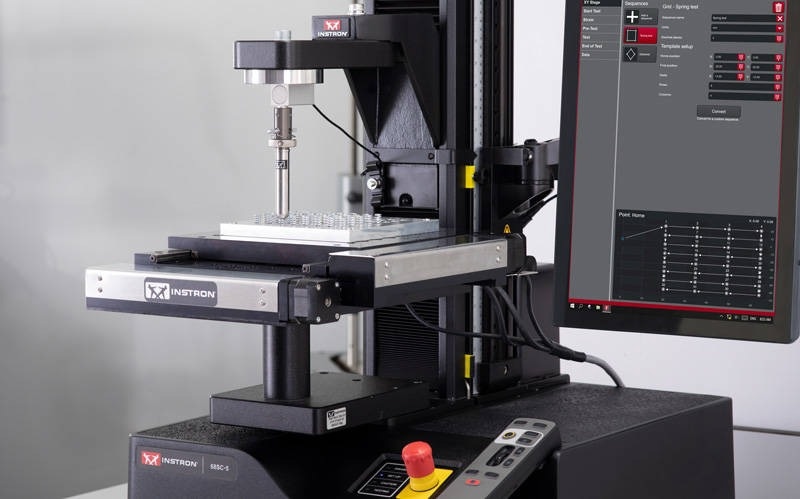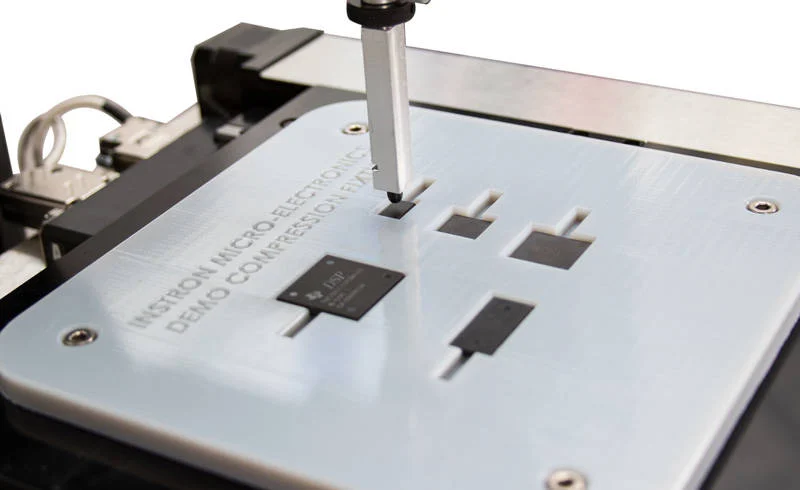Companies eagerly anticipate the introduction of automation to make specific developments in their business, such as reducing costs and creating a more efficient and safer work environment.
Automation can be applied to a number of different processes, from the test labs to the production line. Fully automated materials testing systems are available for testing hundreds of specimens without the need for an operator and can be run overnight.
These systems, however, are not always the best solution for all test labs. Many labs lack the testing volume to make a sound return on investment of a fully automated system. Or, rather than testing material coupons typically associated with an automated system, they may be conducting component testing. For these customers, a semi-automated testing system may be a better option for both their application and budget.
Introducing a semi-automated XY stage to a testing system offers numerous benefits to the lab:
- Greater efficiency allows operators to use their time more effectively
- Increased throughput reduces the overall test time
- Increased repeatability results from more consistent test set up
- Increased safety and ergonomics for operators
AT2 Automated XY Stage Throughput & Efficiency
Video Credit: Instron - Europe
Throughput
Throughput is one of the key metrics in a test lab. The data the lab generates is critical to the overall success of the company; the results may be implemented in product development projects or to verify product quality as it exits the production line. Delays in testing may have detrimental effects on important company targets, such as time-to-market for a new product or distribution deadlines.
The time it takes to run an actual test is fixed, whether the system is automated or manual. Test time is often controlled by international standards such as ISO, ASTM, and EN standards, or by internal company test procedures.
The part of the process that can cause a significant increase in the overall test time are the steps that occur between test-to-test.
First, the tested specimen must be removed, and it should be checked that no remnants are left behind. Then the operator must set up the next specimen carefully, making sure it is correctly positioned and aligned. This process will take time, which can vary depending on how complex the test is as well as the user’s experience.
These are the areas – the time between tests - where a semi-automated system can make a significant contribution to lab throughput.
One example of how an XY stage can improve throughput is to assess the data from benchmark testing performed on springs used in a surgical tool. Fifty specimens were manually run, which took nearly 16 minutes.
The operator-led tests were run one immediately after another, with no breaks or diversions. Typically, an operator who is running tests manually has regular interruptions, such as breaks, meetings, or conversations with colleagues, where testing is put on hold.

Image Credit: Instron - Europe
Using the semi-automated XY system, those same fifty tests only took around 8.5 minutes. The XY system made it possible to test 46% more specimens in the same amount of time. This extra time could benefit several areas of the entire process such as time-to-market, hitting engineering project milestones, or releasing a product for distribution.

Image Credit: Instron - Europe
Customers using an XY system can optimize throughput even further by having several test fixtures available.
While one batch of specimens is being tested, the operator is able to prepare the next batch by placing all the specimens to be tested into the fixture. This reduces downtime between tests significantly, as the operator can set up a new sample on the XY system quickly and then immediately press start.
Backlogs can also be worked through more efficiently, providing faster turnaround on data that is required for R&D projects and on production lines.
Efficiency
While the XY stage enhances lab throughput, it also improves efficiency by giving the operator more time to perform other tasks. The use of automation means the operator is free to walk away from the system and conduct other value-added tasks, such as completion of test reports, data analysis, or measuring and preparing the next batch of specimens for testing.
The benchmark data from the spring tests demonstrates that in addition to boosting the lab throughput by 46% during an 8-hour shift, the operator will theoretically have an additional 3.5 hours of time that would otherwise be consumed when manually running tests. These 3.5 hours is time that can be used much more efficiently.
Repeatability
There are a number of factors that have an impact on repeatability. Specimen placement is crucial: if the specimen is not properly aligned or is at an angle compared with the loading line, this will cause variations in the results.
While there are tools available to aid specimen alignment, operator experience is still crucial in this area, and time and care still must be taken to prepare a specimen. The XY stage has the capacity to position test components or specimens with enhanced repeatability.

Image Credit: Instron - Europe
When specimens are inserted and manually aligned, the operator’s influence on the test results can be particularly noticeable when multiple operators with different levels of experience are running tests on several systems or even across multiple labs. This is compounded when testing numerous points on small components.
The integrated chips displayed in the image above are extremely small. Ensuring that these parts are properly tested in the center and at the same 4 points around the edge can be a challenge when manually preparing the specimens.
An XY system with a well-designed fixture can circumvent such challenges relative to specimen placement and consistency of test locations. An XY stage supplies repeatable test locations from sample to sample, ensuring that the generated data is comparable.
Safety
According to OSHA evaluations, companies in the U.S. pay around $1 billion in direct worker compensation each week, which does not include additional costs related to disturbances in the lab.
If an operator is away on medical leave, the lab’s throughput will likely be reduced due to less staff. If the injured operator knows how to run a specific system or test, that loss of expertise will impact the lab’s capacity to meet its customers’ requirements. Also, lab accidents can have a negative impact on user confidence when operating the equipment.
Reducing the need for operator interaction when using an XY system improves safety, as the operator’s hands rarely need to enter the test space. It also provides improved ergonomics as it eliminates the repetitive motion that is required when manually loading specimens.
Using the XY system means some of the testing challenges around specimen alignment and test points can be removed; thus, operators with less experience can be trained more effectively, making the system easier to use. Moreover, these operators will be more confident when it comes to running the system, reducing overall disruption in the lab.
Summary
Semi-automated systems, such as the XY stage, can offer labs where a fully automated system is not the best solution a series of benefits – throughput, efficiency, repeatability, and safety.
The XY stage enables testing labs to introduce automation on a smaller scale that is well-suited for several different applications, including medical devices, such as vials and syringes, and electronic devices and components.

This information has been sourced, reviewed and adapted from materials provided by Instron - Europe.
For more information on this source, please visit Instron - Europe.